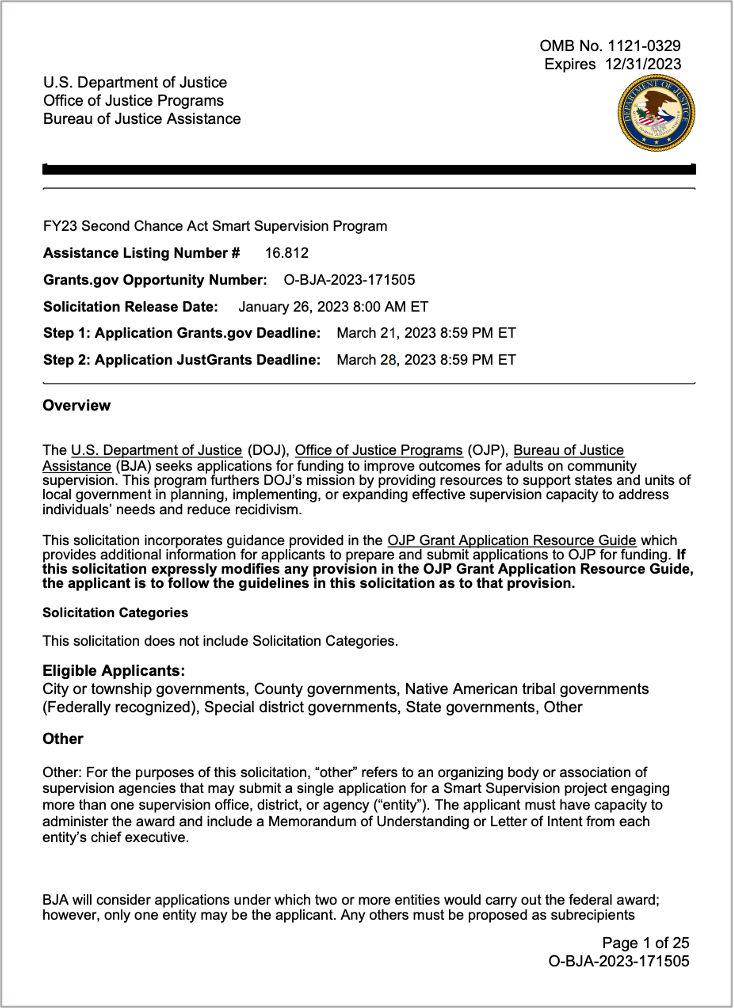Smart Supervision Program (FY 2023)
The Smart Supervision Program provides grants and technical assistance to help agencies build their capacity to help adults successfully complete their supervision and, in the process, desist from crime and lead productive, pro-social lives.
New in FY 2023
In an effort to expand access to Smart Supervision grants, BJA encourages applications from (1) agencies that have not previously received OJP funding to support supervision efforts and (2) convening or governing bodies on behalf of one or more entities within a single jurisdiction in order to facilitate participation by multiple entities therein. For example, a State Administering Agency (SAA) that sets priorities and administers funds within the state, an Administrative Office of the Courts that oversees probation districts, or an association of supervision agencies may submit a single application that details a plan for a Smart Supervision project engaging more than one supervision office, district, or agency (“entity”). The applicant must have capacity to administer the award and include a Memorandum of Understanding or Letter of Intent from each entity’s chief executive. Please note, this is not an exhaustive list of examples. Applicants should consider this grant may meet a wide range of agency needs, from achieving the fundamentals of community supervision to testing innovative approaches and everything in between.
Goals, Objectives, and Deliverables
Goals
- The FY 2023 Smart Supervision Program’s goal is to increase the capacity and increase the ability of probation and parole agencies to improve supervision success rates by more effectively addressing individuals’ risk and needs and reducing recidivism, thereby increasing community safety and reducing crime. Successful efforts not only reduce crime, they also reduce unnecessary admissions to prisons and jails.
Objectives
Agencies are invited to propose grant projects that will improve supervision outcomes for all adults on supervision in their jurisdiction or for a specific subgroup (“target population”) (e.g., females, young adults, a specific geographic area). Applicants may propose one or more of the following:
- Provide training and other skill building opportunities to staff members to be change agents.
- Adopt technology or tools to facilitate more effective supervision by staff.
- Improve the quality and increase the capacity of programs and services to meet the identified needs of adults under supervision.
- Examine and revise policies and practices to align with best and promising practices, and implement changes.
- Focus resources where they can have the greatest impact. a. For example, prioritize services for people who are most likely to recidivate based on the results using validated risk and needs assessment tools and match service delivery to the times when people are most at risk of recidivism by frontloading supervision contacts and services.
- Strengthen the organization’s culture to reduce recidivism through committed leadership and staff engagement.
- Improve supervision officer health and wellness. a. For example, curate resources and training to identify and respond to burnout and vicarious trauma.
- Promote and increase collaboration among justice and other agencies relevant to the supervision population.
- Document and assess the efficacy of the grant-funded intervention or change as part of the practitioner–researcher partnership.
Deliverables
- An action plan consisting of a problem analysis summary, a summary of strategies and intended outcomes, and an initial evaluation plan within 6 months of the award. The assigned TTA provider will supply the action plan and assist grantees to complete it.
- A final report, written with the research partner, that documents the intervention, outcomes, and lessons learned
For more information, see the most recent BJA grant solicitation and materials.




